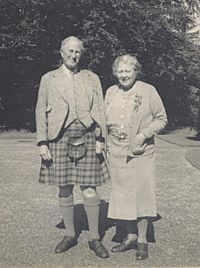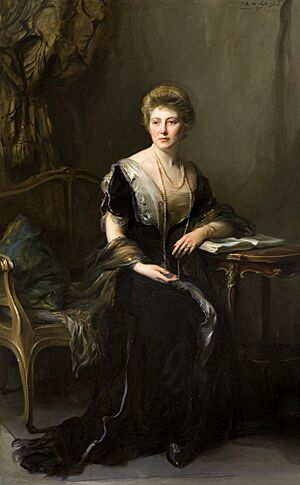James Graham, 6th Duke of Montrose facts for kids
Quick facts for kids
Commodore His Grace
The Duke of Montrose
|
|
|---|---|

The Duke and Duchess of Montrose in the 1940s.
|
|
| Member of the House of Lords Lord Temporal |
|
| In office 10 December 1925 – 20 January 1954 Hereditary Peerage |
|
| Preceded by | The 5th Duke of Montrose |
| Succeeded by | The 7th Duke of Montrose |
| Personal details | |
| Born |
James Graham
1 May 1878 London, England, UK |
| Died | 20 January 1954 (aged 75) Buchanan Castle, Scotland |
| Resting place | Buchanan, Stirlingshire, Scotland, UK |
| Nationality | Scottish |
| Political party | Scottish Party |
| Spouse | Lady Mary Douglas-Hamilton |
| Children | 4, including Angus and Jean |
| Parents | The 5th Duke of Montrose Violet Hermione Graham |
| Occupation | Politician, Naval officer |
| Profession | Engineer |
| Military career | |
| Allegiance | |
| Service/ |
|
| Years of service | 1903–1927 |
| Rank | Commodore |
| Battles/wars | First World War |
| Awards | CB, CVO, VD |
James Graham, the 6th Duke of Montrose (born May 1, 1878 – died January 20, 1954), was an important Scottish figure. He was a nobleman, a naval officer, a politician, and a talented engineer. He is famous for taking the first-ever film of a solar eclipse. He is also known as the inventor of the aircraft carrier, a ship that carries airplanes.
Contents
About James Graham's Life
James Graham was the oldest son of the 5th Duke of Montrose. He went to school at Eton College, a famous school in England. In 1906, he married Lady Mary Douglas-Hamilton. She was the only child of the 12th Duke of Hamilton. James and Mary had four children together. Their children were James (who later became the 7th Duke), Lady Mary Graham, Lord Ronald Graham, and Lady Jean Graham.
James Graham's Career
James Graham had many different careers. He was a sailor, a politician, and an engineer.
James Graham worked in the Merchant Navy and served in South Africa. In 1899, he joined a Royal Astronomical Society trip to India. There, he filmed the first-ever total solar eclipse. In 1900, he helped Lloyd's of London set up wireless telegraph stations in South Africa.
He helped create the Royal Navy Volunteer Reserve (RNVR) in 1903. During World War I, he served in the Auxiliary Naval Service. He later became a Commodore, a high rank, for the RNVR. He was in charge of the entire RNVR from 1921 until he retired in 1927. Because of his service, a ship attached to the Royal Naval Reserve in Dundee was named HMS Montrose after him for many years. Later, a modern warship, Montrose, was also named in his honor.
As a Politician
James Graham was interested in politics from a young age. In 1905, he worked for the Chancellor of the Exchequer, who manages the country's money. He also served as a Naval Aide-de-Camp to the King.
He tried to become a Member of Parliament several times but did not win. In 1925, he became the 6th Duke of Montrose. This meant he entered the House of Lords, which is part of the UK Parliament.
In 1932, he became the chairman of a new political group called the Scottish Party. This party wanted more self-governance for Scotland. In 1934, he helped merge this party with another group. This merger created the modern Scottish National Party (SNP). He was the first President of the SNP. However, he later joined the Liberal Party in 1936.
As an Engineer and Inventor
James Graham was also a brilliant engineer. In 1912, he designed the world's first naval aircraft carrier. He was a director at a company called William Beardmore and Company. They were building a large merchant ship. When World War I started, the work stopped. But in 1916, they decided to turn the ship into an aircraft carrier.
The ship was finished in 1918 and named HMS Argus. It was the first "flat-top" aircraft carrier, meaning it had a flat deck for planes to take off and land. The Duke also designed and owned the first ship that ran on heavy oil.
He was the president of several important engineering groups. These included the British Institution of Marine Engineers and the Junior Institution of Engineers. He was also a vice-president of the Institution of Naval Architects. He was a trustee for the Master Mariners' Company and the commodore of the Sea Cadets in Scotland. From 1935 until his death, he was the president of the National Institute for the Deaf.
Honors and Awards
James Graham received many honors during his life. He was the Lord Lieutenant of Buteshire from 1920 to 1953. This was a representative role for the King in that area. He was also the Lord High Commissioner to the General Assembly of the Church of Scotland in 1942 and 1943.
He received several important awards:
- Commander of the Royal Victorian Order in 1905.
- Companion of the Bath in 1911.
- Knight of the Thistle in 1947.
In 1931, the University of Glasgow gave him an honorary degree. They called him a "great and distinguished Scotsman."
His Later Years and Death
In January 1954, the Duke was staying at a hotel when he had a minor stroke. His health quickly got worse. He passed away on January 20, 1954, about a week after his illness began.


